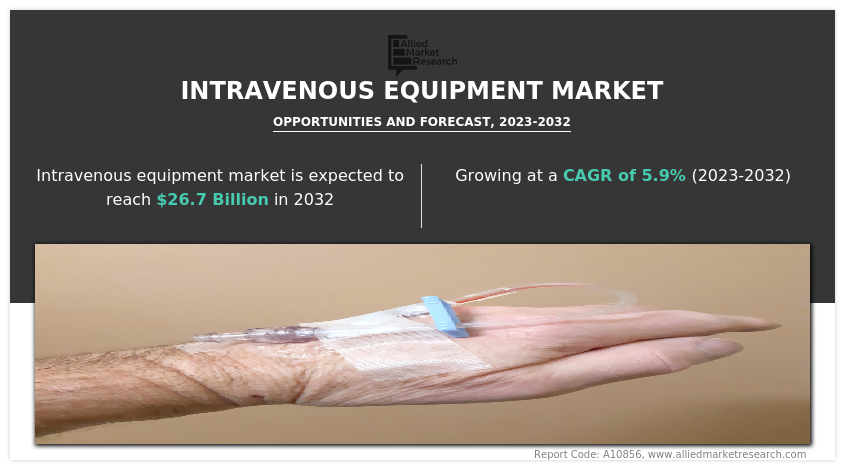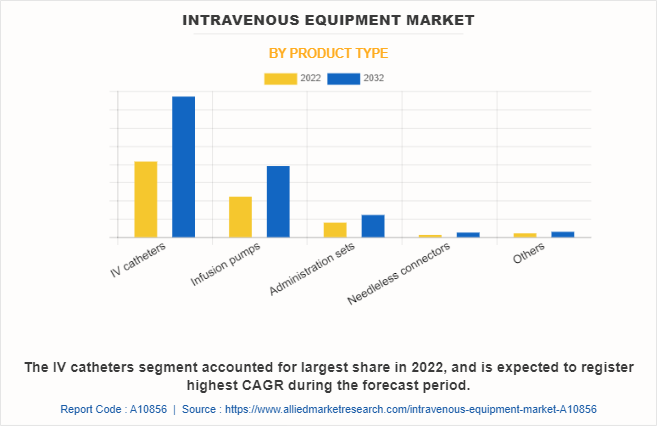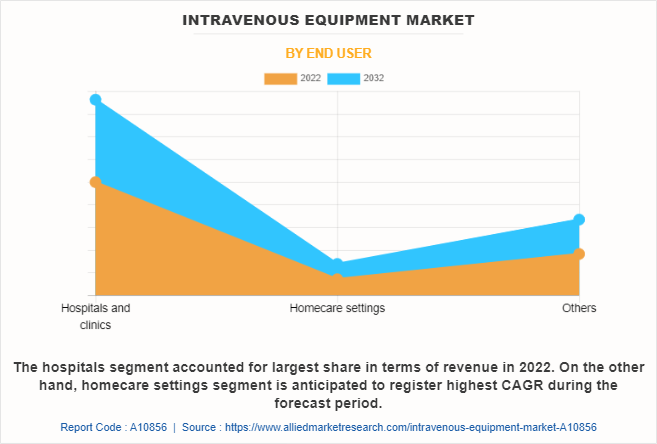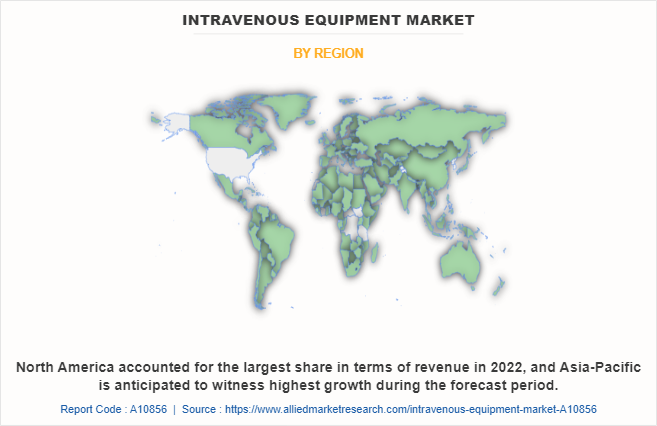IV Equipment Market Research, 2032
The global intravenous equipment market size was valued at $15.0 billion in 2022, and is projected to reach $26.7 billion by 2032, growing at a CAGR of 5.9% from 2023 to 2032. Intravenous equipment refers to the various medical devices and tools used for the administration of fluids, medications, and nutrients directly into the veins of a patient. This equipment is designed to ensure accurate and safe delivery of substances through intravenous therapy. Various intravenous equipment is used such as infusion pumps, IV catheters, administration sets, securement devices, needleless connectors, drip chambers, and stopcocks.

Market Dynamics
The major factors driving the growth of the intravenous equipment market are the increase in prevalence of chronic diseases, surge in aging population, and technological advancements. Chronic diseases such as cardiovascular disorders, diabetes, cancer, and respiratory conditions are on the rise globally. These conditions often require intravenous therapy for effective treatment and management. The increase in prevalence of chronic diseases drives the demand for intravenous equipment, including infusion pumps, catheters, and administration sets.
In addition, the global population is aging, with a significant increase in the number of elderly individuals. As people age, the incidence of chronic diseases and the need for intravenous therapy increases. The growing geriatric population drives the demand for intravenous equipment, as it is essential for delivering medications, fluids, and nutrients to manage and treat various age-related conditions. This demographic shift is a significant driver for the expansion of the IV equipment market.
Further, advancements in healthcare technology play a pivotal role in driving the IV equipment market. Continuous research and development activities lead to the introduction of innovative and technologically advanced intravenous equipment. These advancements aim to enhance patient safety, improve treatment outcomes, and optimize workflow efficiency. Technological advancements in intravenous equipment include smart infusion pumps with integrated monitoring systems, wireless connectivity for seamless data transfer, and improved catheter materials for enhanced performance. These advancements drive the adoption and utilization of advanced intravenous equipment.
Furthermore, surgical procedures often require intravenous therapy for fluid administration and medication delivery. With advancements in surgical techniques and an increase in the number of surgeries being performed, there is a corresponding rise in the demand for intravenous equipment. Operating rooms, ambulatory surgical centers, and other surgical settings require a steady supply of intravenous equipment, including infusion pumps, catheters, and administration sets, to support patient care during surgical procedures. The increasing number of surgical procedures worldwide contributes to the growth of the IV equipment market.
Moreover, patient safety is a key driver in the intravenous (IV) equipment market. Healthcare providers prioritize patient safety and strive to minimize the risk of infections, medication errors, and other complications associated with intravenous therapy. The adoption of advanced intravenous equipment ensures accurate dosage, reduces the risk of needlestick injuries, and enhances infection control aligns with the focus on patient safety. Innovations such as needleless connectors, secure devices, and advanced catheter technologies contribute to improving patient safety and drive the demand for intravenous equipment.
The growth of the intravenous equipment market is expected to be driven by emerging markets, owing to availability of improved healthcare infrastructure, increase in unmet healthcare needs, and rise in prevalence of chronic diseases such as cardiovascular diseases, and diabetes. Furthermore, the healthcare industry in emerging economies is developing at a significant rate, owing to rise in demand for enhanced healthcare services, significant investments by government to improve healthcare infrastructure, and development of the medical tourism industry in emerging countries. Moreover, governments in many countries are investing in healthcare infrastructure and promoting the adoption of advanced intravenous equipment, which drives the IV equipment market size.
In addition, ambulatory care settings, including ambulatory surgical centers, clinics, and outpatient facilities, are witnessing significant growth. These settings provide healthcare services without the need for overnight hospital stays, and intravenous therapy is commonly administered in these facilities. The expansion of ambulatory care settings contributes to the demand for intravenous equipment, as healthcare providers require reliable and efficient equipment for administering intravenous therapy in these settings.
The demand for intravenous equipment is not only limited to developed countries but is also being witnessed in the developing countries, such as China, Brazil, and India, which fuels the growth of the market. Factors such as rise in adoption of intravenous equipment, increase in awareness about chronic disease management, and surge in investments for development of intravenous equipment further drive the IV equipment market growth.
However, the intravenous (IV) equipment market is subject to stringent regulatory requirements and quality standards to ensure patient safety. Compliance with these regulations can be complex and time-consuming, posing challenges for market players in terms of product development, manufacturing, and commercialization. In addition, intravenous therapy carries a risk of infections and complications, such as bloodstream infections, catheter-related bloodstream infections (CRBSIs), and thrombosis. The occurrence of these complications can be a restraint for the intravenous equipment market, as they can lead to increased healthcare costs, patient dissatisfaction, and legal implications.
On the other hand, continuous advancements in technology present significant intravenous equipment market opportunity. Innovations such as wireless connectivity, telemedicine integration, remote monitoring capabilities, and improved catheter materials can enhance the safety, efficiency, and convenience of intravenous therapy, driving IV equipment market growth. In addition, the increase in demand for homecare services provides a significant opportunity for the market. Home-based intravenous therapy requires portable, user-friendly equipment that enables patients to receive treatment in the comfort of their homes. Manufacturers can tap into this growing market by developing specialized intravenous equipment suitable for homecare settings.
The outbreak of COVID-19 has disrupted workflows in the healthcare sector around the world. The COVID-19 pandemic has had a significant impact on the healthcare industry, including the intravenous equipment market. The COVID-19 pandemic has led to a surge in demand for intravenous therapy. Critically ill COVID-19 patients required intravenous fluids, medications, and supportive therapies for effective treatment. This has increased the demand for intravenous equipment such as infusion pumps, catheters, and administration sets.
Further, the pandemic has caused a shift in healthcare delivery, with an increased focus on hospital care for COVID-19 patients. This has led to a higher demand for intravenous equipment in hospitals, including intensive care units and emergency departments. Furthermore, healthcare facilities had implemented stringent measures to prevent the transmission of the virus among patients and healthcare workers. IV equipment with enhanced safety features, such as securement devices and safety-engineered catheters, were being utilized to minimize the risk of contamination and needlestick injuries. Thus, COVID-19 impacted moderately positive on the growth of the intravenous equipment market size.
Segmental Overview
The intravenous equipment industry is segmented into product type, end user, and region. On the basis of product type, the market is categorized into IV catheters, infusion pumps, administration sets, needleless connectors, and others. On the basis of end user, the market is segregated into hospital and clinics, homecare settings and others. Region wise, the market is analyzed across North America (the U.S., Canada, and Mexico), Europe (Germany, France, the UK, Italy, Spain, and rest of Europe), Asia-Pacific (Japan, China, Australia, India, South Korea, and rest of Asia-Pacific), and LAMEA (Brazil, South Africa, Saudi Arabia, and rest of LAMEA).
By Product Type
On the basis of product type, the IV catheters segment accounted for largest intravenous equipment market share in terms of revenue in 2022 and is anticipated to register the highest CAGR during the forecast period. This can be attributed to several factors, including the high incidence of chronic diseases that require IV access, a growing number of surgical procedures, and advancements in catheter technologies that enhance patient comfort and reduce complications.

By End User
By end user, the hospitals and clinics segment accounted for largest share in terms of revenue in 2022, owing to various factors, such as availability and accessibility of specialized departments and units within hospitals, such as ICUs, emergency departments, surgical suites, and general wards, where intravenous therapy is extensively utilized. Hospitals possess the necessary infrastructure, staff, and resources to handle complex cases and advanced medical procedures that often require specialized intravenous equipment. On the other hand, the homecare settings segment is anticipated to register the highest CAGR during the intravenous equipment market forecast period. This can be attributed to factors such as the growing preference among patients to receive medical treatments in the comfort of their own homes and the cost-effectiveness of home-based care. The shift towards homecare settings has led to increased adoption and investment in intravenous equipment tailored for use in home environments.

By Region
North America accounted for the largest share in terms of revenue in 2022, owing to several factors, such as well-developed healthcare infrastructure, high prevalence of diseases, robust reimbursement policies, presence of major market players, technological advancements, and a strong commitment to patient safety. The advanced medical facilities in North America, including hospitals, clinics, and ambulatory surgical centers, drive the demand for intravenous equipment. However, Asia-Pacific is anticipated to witness notable growth, owing to rapidly growing population, which is accompanied by an increasing prevalence of chronic diseases. Thus, there is a significant demand for intravenous therapy and related equipment in the region. Moreover, the surge in healthcare expenditure in emerging economies within Asia-Pacific presents lucrative opportunities for market expansion.

Asia-Pacific is expected to grow at the highest rate during the forecast period owing to technological advancements, increase in prevalence of chronic diseases such as diabetes, cancers, rise in demand for advanced intravenous equipment, surge in investment in healthcare infrastructure, growth in geriatric population, and favorable government initiatives toward use of intravenous equipment for chronic disease management.
Moreover, the region has become a hub for intravenous equipment market owing to its large population base, diverse patient pool, and relatively lower costs of surgery as compared to developed countries. Further, a rise in research activities as well as the well-established presence of domestic companies in the region are expected to provide notable opportunities for the market growth. In addition, a rise in contract manufacturing organizations within the region is expected to open new avenues for the IV equipment market growth.
Competitive Landscape
Competition analysis and profiles of the major players in the intravenous equipment industry such as Becton, Dickinson and Company, B. Braun SE, ICU Medical, Inc., vygon, Baxter International Inc., Teleflex Incorporated., 3M Company, AngioDynamics, Inc., Terumo Corporation and Poly Medicure Ltd. are provided in this report. Major players have adopted product approval as a key developmental strategy to strengthen their foothold in the market.
Recent Key Strategies and Developments
In August 2022, Baxter International Inc. received the U.S. Food and Drug Administration (FDA) 510(k) clearance for its new Novum IQ syringe infusion pump (SYR) with Dose IQ Safety Software, representing Baxter’s latest developments for infusion therapy.
Key Benefits for Stakeholders
- This report provides a quantitative analysis of the market segments, current trends, estimations, and dynamics of the intravenous equipment market analysis from 2022 to 2032 to identify the prevailing intravenous equipment market opportunities.
- The market research is offered along with information related to key drivers, restraints, and opportunities.
- Porter's five forces analysis highlights the potency of buyers and suppliers to enable stakeholders make profit-oriented business decisions and strengthen their supplier-buyer network.
- In-depth analysis of the intravenous equipment market segmentation assists to determine the prevailing market opportunities.
- Major countries in each region are mapped according to their revenue contribution to the global market.
- Market player positioning facilitates benchmarking and provides a clear understanding of the present position of the market players.
- The report includes the analysis of the regional as well as global IV equipment market trends, key players, market segments, application areas, and market growth strategies.
Intravenous Equipment Market Report Highlights
| Aspects | Details |
| Market Size By 2032 | USD 26.7 billion |
| Growth Rate | CAGR of 5.9% |
| Forecast period | 2022 - 2032 |
| Report Pages | 250 |
| By Product Type |
|
| By End User |
|
| By Region |
|
| Key Market Players | Teleflex Incorporated., Vygon, B. Braun SE, ICU Medical, Inc., Becton, Dickinson and Company, Poly Medicure Ltd., Baxter International Inc., AngioDynamics, Inc., Terumo Corporation, 3M Company |
Analyst Review
This section provides various opinions in the global intravenous equipment market. The global intravenous equipment market is expected to grow owing to increasing demand for intravenous therapy across various healthcare settings, including hospitals and clinics ambulatory surgical centers, and homecare settings. The rising prevalence of chronic diseases, the need for efficient drug delivery systems, and advancements in medical treatments drive the demand for intravenous equipment globally.
Further, rise in expenditure on the development of healthcare infrastructure and rise in geriatric population are expected to boost the growth of intravenous equipment market. In addition, investments in R&D aim to develop innovative and technologically advanced products that enhance patient safety, improve treatment outcomes, and optimize workflow efficiency. These investments focus on areas such as infusion pumps, catheters, connectors, and other accessories to address the evolving needs of healthcare providers and patients.
North America accounted for the largest share in terms of revenue in 2022, owing to its well-developed healthcare infrastructure, high disease prevalence, robust reimbursement policies, presence of key market players, technological advancements, and commitment to patient safety. However, Asia-Pacific is anticipated to witness notable growth, owing to rapidly growing population, coupled with the increasing prevalence of chronic diseases, creates a significant demand for intravenous therapy and related equipment. The upsurge in healthcare expenditure in the emerging economies is anticipated to offer lucrative opportunities for the market expansion.
The total market value of intravenous equipment market is $15,035.59 million in 2022.
The market value of intravenous equipment market in 2032 is $26,726.20 million.
The forecast period for intravenous equipment market is 2023 to 2032.
The base year is 2022 in intravenous equipment market.
Top companies such as Becton, Dickinson and Company, B. Braun SE, ICU Medical Inc., Baxter International Inc., and Poly Medicure Ltd., held a high market position in 2022. These key players held a high market position owing to the strong geographical foothold in North America, Europe, Asia-Pacific, and LAMEA.
The IV catheters segment is the most influencing segment in intravenous equipment market owing to factors such as the high prevalence of chronic diseases requiring IV access, the increasing number of surgical procedures, and advancements in catheter technologies improving patient comfort and reducing complications.
The major factors that fuel the growth of the intravenous equipment market are increase in number of people suffering from chronic conditions, rise in geriatric population, and continuous advancements in IV equipment technology.
Intravenous equipment refers to the tools and devices used in intravenous therapy, a medical procedure that involves delivering fluids, medications, or nutrients directly into a patient's bloodstream through a vein.
Loading Table Of Content...
Loading Research Methodology...



